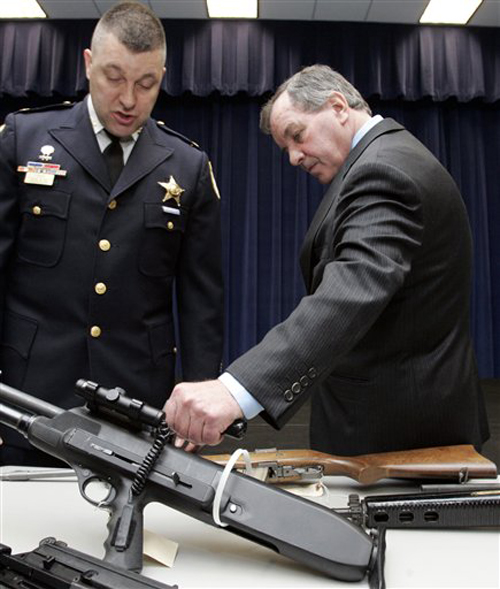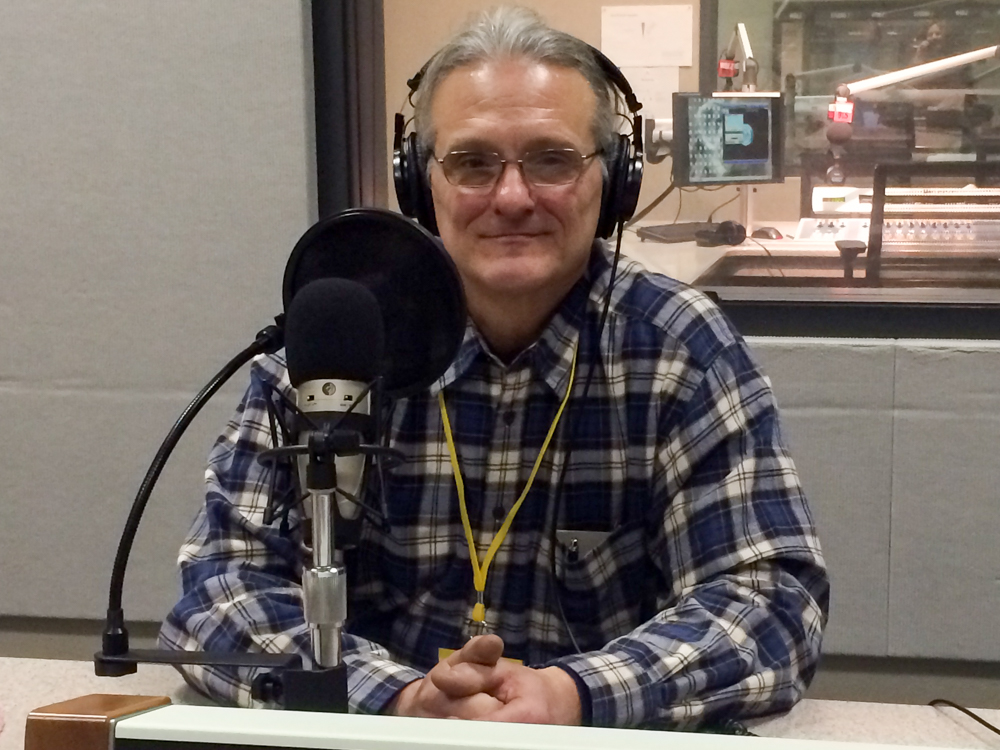What Happened to Chicago’s Rifle Ranges?
By Ellen Mayer

What Happened to Chicago’s Rifle Ranges?
By Ellen MayerIn Chicago, talk of guns generally revolves around gun violence and gun control, so it’s no surprise Curious City sees many questions along those lines.
One question broke that mold, though; it’s about gun ranges and shooting as a sport. The guy behind the question is Bob Collar, from Homewood, Illinois.
Bob grew up shooting smallbore rifle, a competitive sport named for the kind of rifles they use (most commonly .22 caliber). Bob says shooters used to practice at ranges all over Chicago. Off the top of his head, Bob can rattle off a long list of range locations: the ComEd building at Cermak and Wabash, the University of Chicago, the Madison Street Armory, and the Chicago Armory, to name a few.
Chances are, you’ve never heard of any of these ranges because they no longer exist. In fact, there isn’t a single shooting range open to the general public in Chicago today, for rifles or otherwise. That’s what makes Bob’s question so great:
What happened to all the indoor smallbore rifle ranges I used to frequent?
While uncovering the fate of Bob’s old stomping grounds, we look back to a time when some Chicagoans had a different relationship to guns, and we also found someone trying to bring shooting ranges back to the city, but likely for different reasons than Bob’s rifle sport.
Chicago at the shooting range
There have been rifle clubs in Chicago since the Civil War, but rifle really took off during World War I, thanks to support from Chicago’s main power utility, Commonwealth-Edison. The company wanted to popularize the rifle sport and help prepare civilians for combat. In 1918 ComEd built its own rifle range in the middle of downtown, and it sponsored a city-wide rifle league. That year, the Chicago Tribune declared the league a great success: “Every week now clubs are inquiring how to join and the attendance of fans is increasing with every shoot.”
At the time, it was common for big corporations to sponsor sports and other recreational activities for their workers. Through the 1960s, Chicago had a vibrant culture of industrial sports leagues. Companies competed against each other in bowling leagues, basketball, and yes, rifle. Aside from ComEd, companies like People’s Gas, Kodak, and Bell Telephone all sponsored their own rifle clubs.
When Bob started shooting, in the 1960s, he was competing in the very same rifle league that ComEd started back in 1918. He even shot on a ComEd range. By Bob’s era, though, Chicago’s industrial sports leagues were on the decline. The city lost manufacturing jobs, and as companies tightened their budgets, sport rifle went down, along with billiards and bowling.
Bob quit shooting for a time, and when he came back in the ‘80s, his rifle club had lost access to the ComEd range and moved to the suburbs. He doesn’t know what happened to the old ranges.
So, where did they go?
The quick answer is that the ranges were torn down. The ComEd range at Cermak and Wabash is now just an empty lot. The same is true for the West Town Armory on Madison. The University of Chicago had a range underneath the stands of Stagg Field, but that entire complex was torn down in 1957. The Chicago armory was demolished in 1993 to make way for the Museum of Contemporary Art.
![Students in the advanced rifle marksmanship class at the University of Chicago practice shooting in the university’s West Stand range. Students in the advanced class, sponsored by the Institute of Military Studies at the time, regularly passed tests for the highest Army small-bore ranking. (Photo courtesy University of Chicago Photographic Archive, [apf4-00833], Special Collections Research Center, University of Chicago Library.)](https://s3.amazonaws.com/wbez-cdn/legacy/image/range-for-web-2.png)
Shifting attitudes
Another major reason for the decline of rifle sports in Chicago is that public opinion about guns shifted. Gerry Souter documented the shift in his book The American Shooter: A Personal History of Gun Culture In The United States. He grew up in Chicago in the 1950s, when competitive rifle was a popular sport for young people, and rifles were considered wholesome Christmas gifts.
“It was just like kids get skates or a baseball glove,” Souter says, “but a rifle, that really showed your parents respected your ability to discipline yourself and your use of it.” (Incidentally, Souter learned to shoot with his Boy Scout troupe. His high school ROTC rifle team competed against teens across the city, at schools such as Lane Tech and Hyde Park High School.)

Why didn’t competitive rifle stay popular? Souter says that political polarization around guns is to blame. On one side of the gun debate, there’s the National Rifle Association. The NRA started as a sportsman’s group, dedicated to promoting marksmanship, hunting, and gun safety. But in the 1970s, the N.R.A. took a sharp turn to the right. It became a politicized lobbying group, and began promoting guns not just for sport but for self-defense. Souter is a member of the NRA, but he says the political shift was alienating. “It actually injected a fair amount of paranoia into the sport,” Souter says. “They created a ‘them or us attitude,’ and that soured many shooters.”
At the same time, gun violence was increasing in Chicago and around the country. According to Pew Research Center, the national gun homicide rate began rising in the 1960s and surged in the 1970s. In big cities like Chicago, this steep increase was especially startling. 1974 was the city’s deadliest year on record, with 970 people killed by gunfire.
As gun violence rose, so did anti-gun sentiment. The Chicago city government took a hard line on gun control, and, Souter says, parents really didn’t want their kids around guns. “The parents didn’t want them to have their eye shot out,” he says, “or they feared the elements that would come to these ranges or come to these gun stores, and that was a negative that just really killed the sport.”
Not a shooting range in sight
Today, there are commercial shooting ranges in suburbs like Lombard, Lyons and Des Plaines. If you drive further, you can find private rifle clubs in Wheaton, Elgin, or Rockford. Still, there isn’t a single range within Chicago’s city limits where Bob can shoot his rifle.
In 2010, the Daley administration imposed a blanket ban on shooting ranges, while also requiring that anyone seeking a gun permit must undergo an hour of range training. In other words, Chicago residents were required to travel to a range in the suburbs in order to receive their permit.

In 2011, the 7th Circuit Court of Appeals struck down the gun range ban. In response, the City Council passed new ordinances for licensing and zoning gun ranges. The ordinances regulate everything from security, to air ventilation, to the hours that a range is allowed to operate. In addition, the zoning ordinance requires that a rifle range can only be opened in a manufacturing district. It must be more than 500 feet from any residential area, school, park, or place of worship.
The city’s law department argues that Chicago’s gun range ordinances “set reasonable, common-sense health and safety restrictions and are a collection of best practices from around the country.” According to the department, these restrictions protect public safety by “reducing the risk of danger from lead contamination from ranges, and by preventing gun trafficking.”
Gun ranges’ return?
Even though gun ranges are technically legal in Chicago, many gun ownership advocates believe the licensing and zoning requirements are onerous enough to comprise a de facto ban. Using that argument, the Second Amendment Foundation took the city to court in 2014. That case is currently on appeal.
The current court action hasn’t stopped Christopher O’Connor from scouting locations for The Firearms Defense Training Center, a gun range and store that he plans to open in Chicago. O’Connor believes the zoning ordinances are designed to make his job impossible, but he’s confident he can outsmart City Hall.
“I’m not even looking for a loophole,” O’Connor says. “I’m looking for a hidden gem. I’m looking for a thing that they overlooked and the places that they may not conceive of.”
O’Connor says he’s collected market research that suggests a real demand for a gun range in the city. “Anyone that owns a gun will tell you they don’t get enough time at the range,” he says. “In the city of Chicago, that’s excruciating because you have to leave Chicago city limits to go to a gun range and practice to make sure that you’re proficient and safe.”
Would Bob shoot at O’Connor’s range? He says he doesn’t think so. Bob is looking for an old-style range for small bore rifle. Though O’Connor would welcome rifles, he plans to gear his range more toward handguns and self-defense.
Even though we couldn’t find Bob a place to shoot his rifle, he’s glad to show Chicagoans that there’s another side to firearms.
“I think there’s more people like me that truly love shooting because it’s a sport,” he says. “I’m just hoping that there might be enough people with enough open-mindedness left that would look at the question and think that maybe it’s not all bad.”
A final note about this story: We limited the scope of our investigation to rifle ranges (as opposed to handguns, trap, or skeet). We know that rifle ranges disappeared from Chicago, but even our sources had a hard time nailing down exactly when the last one went dark. If you have suggestions or leads about that, we’d love to hear from you and update the story. Please leave a comment or write: curiouscity@wbez.org
Who’s Bob Collar, anyway?

If you’re confused how to pronounce Bob’s last name, he’ll clear things up for you right away: “I’m Bob Collar, like you got on your shirt.” He adds, “I’ve heard all the jokes.”
Bob spent his early childhood on the city’s South Side, but his parents moved to Homewood, a south suburb, because “they decided that I couldn’t go to an all black school.” His family ran a hardware store in Chicago’s Woodlawn neighborhood.
After school, he used to take the commuter rail into Chicago to work a few hours at the family store. Then he’d head to the rifle range. (This was back when it was perfectly normal to carry your rifle on the train!) For Bob, the community aspect of his rifle club was just as important as the sport itself.
“It was a chance for me as a male to be around males of different generations,” Bob says. “It’s hard for me to really explain that bonding. I don’t know what the fancy words are, but it was really good for me to be judged by my peers of different ages.”
Today, Bob still lives in Homewood and works as a handyman. He’s a lifetime member of the NRA, and he’s still looking for a place to shoot his German smallbore rifle. He says, “I guess my itch can’t be cured without a time machine.”
Ellen Mayer is a Chicago-based journalist. Follow her @ellenrebeccam.




